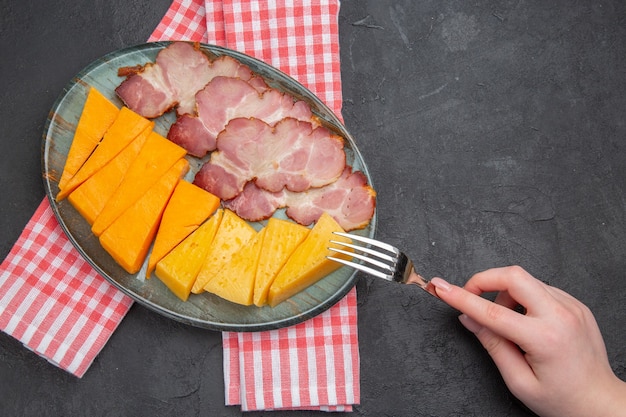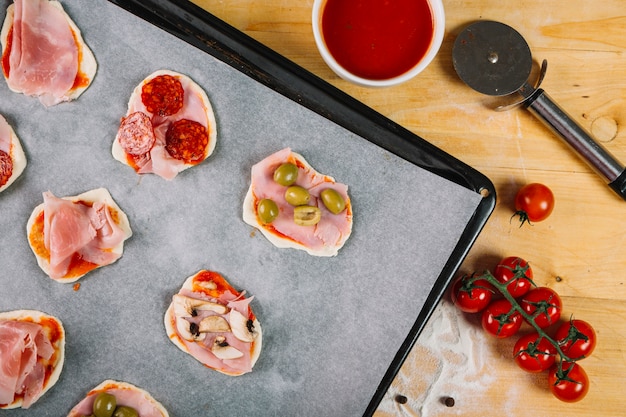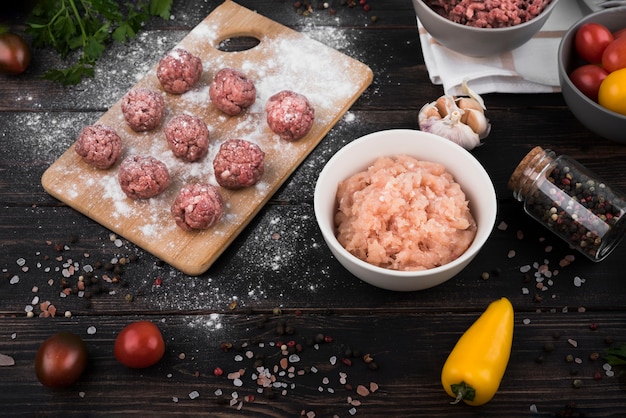(Part 1) Choosing Your Ham: The Foundation of a Delicious Feast

The Great Ham Debate: Bone-In vs. Boneless - Which Side Are You On?
Ah, the eternal question! Bone-in or boneless? It's a choice that reflects your cooking style and preferences, and honestly, there's no wrong answer. I personally lean towards bone-in hams. There's a certain charm in that big, beautiful bone, and it adds a touch of rustic elegance to the dish. Plus, the bone marrow imparts a rich, flavourful depth that's simply irresistible. And let's be real, carving a bone-in ham can be a fun, almost theatrical experience. However, boneless hams are undeniably convenient. They're pre-sliced, making them ideal for quick meals and casual gatherings. Plus, they offer a more compact presentation, perfect for smaller tables or when you're looking for a less-cluttered centerpiece.The Ham Family: A Journey Through Flavour and Texture
Beyond the bone question, there's a whole world of ham types, each with its own unique characteristics. Let's explore them: city ham: Think of city ham as the sophisticated cousin of the ham family. These hams undergo a long, slow curing and smoking process, resulting in a deep, complex flavour and a dry texture. Imagine them thinly sliced and adorning a charcuterie board, their rich taste a delightful contrast to the other elements. country ham: Now, these are the hams with a story to tell. Cured and smoked for an extended period, they are truly aged, developing an intense, almost salty flavour. The texture is firm, almost chewy, and they're typically served in paper-thin slices, their flavour a revelation. spiral-sliced ham: This is the everyday hero of the ham world. Pre-sliced for convenience, it's a go-to for busy weeknights and casual gatherings. You can easily pop it in the oven, heat it up, and serve it with minimal fuss. cooked ham: If you're pressed for time, cooked ham is your best friend. It's fully cooked, ready to eat right out of the package. Great for picnics, potlucks, or just a quick and easy dinner. fresh ham: For the true ham enthusiasts, there's fresh ham. Uncured and uncooked, it offers ultimate control over flavour and texture. You can brine it, cure it, smoke it, or cook it according to your own vision.Size Matters: Picking the perfect ham for Your Crowd
Once you've decided on the type of ham, it's time to consider the size. How many hungry mouths are you planning to feed? Do you want enough for leftovers? A good rule of thumb is to allow about 1/2 pound of ham per person.A Little Bit About Quality: Ensuring Your Ham is a Star
You wouldn't settle for just any ingredient in your favourite recipe, would you? The same applies to your ham. Here's what to look for: Colour: A good ham should have a consistent, even colour, free from any discolouration or dullness. Texture: The ham should feel firm to the touch, not mushy or watery. It should have a springy texture, indicating freshness. Smell: A fresh ham should have a pleasant, slightly smoky aroma. Trust your senses!(Part 2) Preparing Your Ham: Laying the Foundation for Deliciousness

The Essential "Rinse and Dry": Setting the Stage for Flavour
Alright, you've got your chosen ham, now it's time to get it ready for its transformation. Give it a good rinse under cold running water, gently removing any loose bits and pieces. Then, pat it dry thoroughly with paper towels. You want a nice, dry surface for the glaze to adhere to, creating that beautiful caramelized crust.The Glazing Game: A Symphony of Sweet, Savoury, and Smoky Flavours
This is where the magic truly happens! Glazing is the key to elevating your ham from good to great, infusing it with flavour and creating a beautiful, glossy finish.Classic Glaze Recipe: A Harmony of Flavours
- 1/2 cup brown sugar: Adds sweetness and a rich caramel flavour.
- 1/4 cup honey: Provides a touch of natural sweetness and helps the glaze caramelize beautifully.
- 2 tablespoons Dijon mustard: A tangy punch that adds depth and complexity to the glaze.
- 1 tablespoon apple cider vinegar: Offers a subtle acidity that balances the sweetness of the glaze.
Combine all ingredients in a saucepan over medium heat. Bring to a boil, then reduce heat to low and simmer for about 5 minutes, or until the glaze thickens slightly. The glaze should be thick enough to coat the ham without being too runny.
The Art of Scoring: Unlocking Flavour and Enhancing Aesthetics
Here's a little secret that elevates the ham's flavour and appearance: scoring. Using a sharp knife, make shallow cuts into the fat layer, creating a diamond pattern or crisscross lines. This allows the glaze to penetrate deeper into the ham, and the fat to render more evenly, resulting in a crispier, more flavourful crust.(Part 3) Cooking Your Ham: Techniques to Suit Your Style and Time

The oven method: A Tried and True Classic
This is the traditional, reliable way to cook a ham, and it rarely disappoints. Here's how to achieve oven-baked perfection: Preheat your oven: Set it to 325 degrees Fahrenheit (160 degrees Celsius). Prepare the roasting pan: Choose a pan large enough to accommodate the ham and any drippings. Add a little moisture: Pour a cup or two of water into the bottom of the pan. This creates steam, helping to keep the ham moist during cooking. Place the ham in the pan: Make sure it fits comfortably. Bake until cooked through: The ham is cooked when the internal temperature reaches 145 degrees Fahrenheit (63 degrees Celsius). This usually takes about 15-20 minutes per pound. Let it rest: Once the ham is cooked, cover it loosely with aluminum foil and let it rest for 10-15 minutes before carving. This allows the juices to redistribute, resulting in a more tender and juicy ham.The slow cooker method: Effortless Elegance for Busy Days
For a hands-off approach that delivers a wonderfully tender ham, the slow cooker is your go-to. Here's how to make it work: Place the ham in the slow cooker: Ensure it fits comfortably without overcrowding the pot. Add liquid for moisture: Pour a cup or two of water, apple juice, or even cola into the slow cooker. This helps keep the ham moist and prevents it from drying out. Cook on low or high: Cook on low for 6-8 hours, or on high for 3-4 hours. The exact cooking time will depend on the size of the ham. Let it rest: Once the ham is cooked, remove it from the slow cooker and let it rest for 15-20 minutes before carving.Other Cooking Options: Exploring Beyond the Basics
If you're feeling adventurous, there's a whole world of ham-cooking possibilities beyond the oven and slow cooker. Grilling: For a smoky, chargrilled flavour, try grilling your ham. Just be mindful of the heat and watch it closely, as it can cook quickly. Smoker: For an authentic barbecue flavour that's truly special, smoke your ham in a smoker. It takes time, but the results are worth the wait.(Part 4) Glazing: Transforming Your Ham into a Masterpiece
Now, here's where your ham truly begins to shine. Glazing isn't just about adding flavour, it's about creating a beautiful, caramelized finish that elevates the ham to a work of culinary art.Timing is Key: Bringing Out the Glaze's Best
You'll want to glaze your ham about 30 minutes before it's finished cooking. This allows the glaze to caramelize and develop that luscious golden brown colour.The Glazing Technique: A Brushstroke of Flavour
Using a pastry brush, generously coat the ham with your chosen glaze. Don't be shy – you want a good, even layer. You can even brush the glaze on multiple times during the last 30 minutes of cooking, adding layers of flavour and texture.Additional Glaze Tips: Secrets to Perfection
Keep an eye on the glaze: As the glaze cooks, it will start to bubble and caramelize. If it begins to burn, slightly reduce the oven temperature. Add a splash of water: If the glaze starts to dry out, add a small amount of water to the roasting pan. This helps keep it moist and prevents it from sticking. Don't forget the sides: Don't just glaze the top. Get those sides and even the bottom glazed for that all-around deliciousness.(Part 5) The Art of Carving: A Skill to Master
Your beautifully glazed ham, cooked to perfection, is ready for its grand unveiling. Carving, however, isn't just about slicing – it's about showcasing the ham's beauty and ensuring each piece is perfect.Getting Started: Gather Your Tools
You'll need a good carving knife – sharp, pointy, and comfortable in your hand. A carving fork is also essential for holding the ham steady while you carve.The Carving Technique: A Step-by-Step Guide
1. Remove the rind: Use your knife to make a clean slice around the ham, removing the outer layer. This helps to expose the delicious meat beneath.2. Start slicing: Work your way through the ham, making thin, even slices. Aim for slices that are about 1/4 inch thick.3. Cut along the bone: If you're working with a bone-in ham, carefully cut along the bone, separating the meat.4. Arrange and serve: Arrange the slices on a platter, creating a visually appealing display. Serve alongside your favourite side dishes.(Part 6) Leftovers: Turning leftover ham into a Feast
Leftover ham? Don't even think about throwing it away! This is where your creativity truly shines. Leftover ham is a blank canvas for culinary adventures, offering a multitude of delicious possibilities.From Sandwich to Soup: Delicious Leftover ham recipes
ham and cheese sandwiches: A classic for a reason! Use leftover ham in sandwiches with your favourite cheeses, mustard, and breads. Ham and pea soup: This hearty and comforting soup is perfect for a chilly day. Add leftover ham, peas, carrots, potatoes, and your favourite broth to a pot and simmer until the vegetables are tender. ham and bean casserole: This satisfying casserole is perfect for a family gathering. Combine leftover ham, beans, corn, and your favourite seasonings in a baking dish and bake until bubbly. Ham and Potato Hash: A quick and easy breakfast or brunch option. Sauté leftover ham with potatoes, onions, and peppers for a flavourful hash. ham and cheese quiche: This elegant and satisfying quiche is perfect for a light lunch or dinner. Combine leftover ham, cheese, eggs, and cream in a pie crust and bake until set.(Part 7) Serving Your Ham: Presentation Matters
You've cooked your ham to perfection, carved it beautifully, and have a host of delicious leftover ideas. Now it's time to create a stunning presentation that reflects the effort and care you've put into your dish.The Platter: A Stage for Your Culinary Masterpiece
Choose a platter that's large enough to accommodate the ham and any side dishes you plan to serve. Consider using a classic wooden platter, a sleek marble one, or even a colourful ceramic platter.Side Dishes: The Perfect Harmony
Select side dishes that complement the ham's flavour and create a visually appealing contrast. mashed potatoes: A timeless classic that provides a creamy contrast to the ham. green beans: A vibrant and healthy option that adds a touch of freshness and colour. Roasted vegetables: Versatile and delicious, roasted vegetables can be customized with your favourite flavours and seasonings. fruit salad: A light and refreshing side that balances the richness of the ham.(Part 8) FAQs: Your ham cooking Questions Answered
Q: How long should I cook a ham?
A: The cooking time depends on the size of the ham. A good rule of thumb is to cook it for about 15-20 minutes per pound. Always check the internal temperature with a meat thermometer to ensure it's cooked to 145 degrees Fahrenheit (63 degrees Celsius).
Q: Can I freeze leftover ham?
A: Absolutely! Leftover ham can be frozen for up to 3 months. Wrap it tightly in plastic wrap or aluminum foil before storing it in the freezer.
Q: What if my ham is too salty?
A: Soaking the ham in cold water for a few hours can help to reduce the saltiness. You can also serve the ham with a sweet or acidic side dish, like a fruit salad or cranberry sauce, to balance the flavour.
Q: What are some good glaze recipes for ham?
A: The possibilities are endless! Here are a few ideas:
- brown sugar glaze: Combine brown sugar, honey, and mustard for a classic, sweet-savoury glaze.
- maple glaze: Use maple syrup, brown sugar, and cinnamon for a sweet and smoky glaze with a touch of warmth.
- cherry glaze: Add cherry preserves, brown sugar, and red wine vinegar for a tart and fruity glaze that adds complexity and depth.
- pineapple glaze: Combine pineapple juice, brown sugar, and a touch of ginger for a sweet and tangy glaze.
Q: How do I know if my ham is fully cooked?
A: Use a meat thermometer to check the internal temperature of the ham. It should reach 145 degrees Fahrenheit (63 degrees Celsius) for safe consumption.
Now, you're equipped with the knowledge and confidence to cook a ham that will impress your guests and leave you feeling like a culinary maestro. Gather your ingredients, invite your loved ones, and let's create a delicious memory together!Everyone is watching

How to Cook Frozen Lobster Tails Perfectly: A Step-by-Step Guide
RecipesLobster. Just the word conjures up images of lavish meals, special occasions, and a taste of luxury. But let's...

Pork Fillet Cooking Time: How Long to Cook It Perfectly
RecipesPork fillet, or tenderloin as it's sometimes called, is a real favourite in our house. It's so versatile, and...

Pigs in a Blanket Cooking Time: How Long to Bake for Perfect Results
RecipesAh, pigs in a blanket. Just the name conjures up images of those delightful little parcels of crispy pastry en...

The Ultimate Guide to Cooking Delicious Frankfurters
RecipesLet's face it, we all love a good frankfurter. It's a classic, simple, and always satisfying. But let's be rea...

Wolf Meat Recipes: A Guide to Cooking Wild Game
RecipesLet's be honest, you don't see wolf meat at your local butcher shop every day. It's a bit of a wild card, but ...
